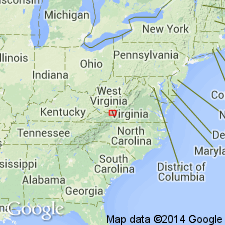
- Usage in publication:
-
- Eggleston limestone
- Modifications:
-
- Named
- Dominant lithology:
-
- Limestone
- Bentonite
- AAPG geologic province:
-
- Appalachian basin
Summary:
Named the Eggleston limestone for Eggleston, Giles Co., VA. Consists of thin- to thick-bedded, fine-grained, argillaceous, dark buff to light brown limestone which upon fracturing forms cuneiform blocks with the jointing perpendicular to bedding. Also contains many thin beds and a few thicker beds of bentonite. Unit is more than 150 feet thick at type locality and overlies the Moccasin member of the Lowville formation. The Eggleston is of Middle Ordovician (Blackriveran) age.
Source: GNU records (USGS DDS-6; Reston GNULEX).
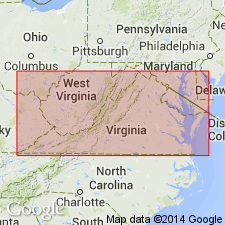
- Usage in publication:
-
- Eggleston
- Modifications:
-
- Not used
- AAPG geologic province:
-
- Appalachian basin
Summary:
Author believes that the Eggleston is not a valid formation; considered a facies of the Black River, transitional between the red Moccasin facies and the overlying Trenton facies of the Martinsburg.
Source: GNU records (USGS DDS-6; Reston GNULEX).
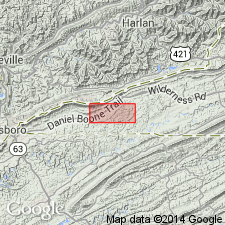
- Usage in publication:
-
- Eggleston limestone*
- Modifications:
-
- Overview
- AAPG geologic province:
-
- Appalachian basin
Summary:
The Eggleston limestone consists of buff-weathering earthy calcareous siltstone at the base and top, and thin-bedded fine-grained moderately fossiliferous limestone in the middle. Two thick and several thin bentonite beds occur in the upper part of the formation. Unit is 135 to 165 feet thick. It overlies the Hardy Creek member of the Moccasin limestone and underlies the Trenton limestone. The Eggleston is of Middle Ordovician age.
Source: GNU records (USGS DDS-6; Reston GNULEX).
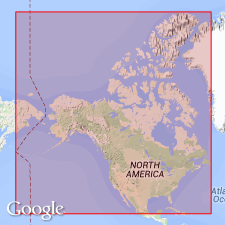
- Usage in publication:
-
- Eggleston formation
- Modifications:
-
- Areal extent
- AAPG geologic province:
-
- Appalachian basin
Summary:
Geographically extended the Eggleston formation to northeastern TN. Formation appears in western belts of southwestern VA and eastern TN on northwest slope of Wallen Ridge from TN nearly to Big Stone Gap, and throughout Russell and Giles Cos., VA.
Source: GNU records (USGS DDS-6; Reston GNULEX).
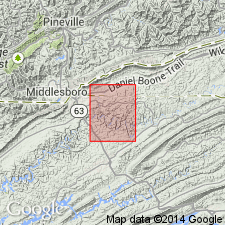
- Usage in publication:
-
- Eggleston limestone*
- Modifications:
-
- Revised
- AAPG geologic province:
-
- Appalachian basin
Summary:
The Eggleston Limestone in northeastern TN is considered a formation within the Chickamauga Group. Consists of yellowish gray argillaceous limestone in the lower and upper part, and olive gray calcilutite, locally with olive black chert nodules in the middle part. Two thick greenish gray bentonite beds occur in the upper part. Thickness is 150 feet. Unit overlies the Hardy Creek Limestone and underlies the Trenton Limestone. The Eggleston is of Middle Ordovician age.
Source: GNU records (USGS DDS-6; Reston GNULEX).
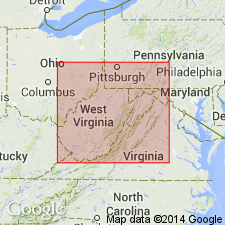
- Usage in publication:
-
- Eggleston Formation
- Modifications:
-
- Areal extent
- AAPG geologic province:
-
- Appalachian basin
Summary:
Geographically extended the Eggleston Formation to WV as part of the Trenton Group.
Source: GNU records (USGS DDS-6; Reston GNULEX).
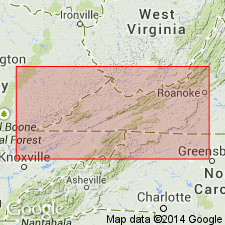
- Usage in publication:
-
- Eggleston Formation
- Modifications:
-
- Overview
- AAPG geologic province:
-
- Appalachian basin
Summary:
Three Rocklandian K-bentonite beds occur in the Valley and Ridge province of southwest VA, southeast WV, and northeast TN. The older two are identified as the Deicke and Millbrig K-bentonite Beds, mapped previously in the Upper Mississippi Valley. At Hagan, and several other places in southwestern VA, the Deicke and Millbrig occur in the Eggleston Formation. Using the bentonites as time lines, it has been determined that the bases of the Eggleston, Bays, and Trenton ("Martinsburg") Formations become younger to the northeast. The Eggleston overlies the Moccasin Formation in the central belt, but a thicker Eggleston is partly equivalent to the Moccasin in the western belt. It thins rapidly along the southern end of Clinch Mountain in TN and the entire interval between the Witten Formation and the Trenton ("Martinsburg") Formation in the central belt is assigned to the Moccasin. Faunal abundance and diversity is greatest in the Powell Valley, but bioclastic grainstones containing gastropods, brachiopods, bryozoans, and crinoids occur throughout the Eggleston. Correlation charts. Cross sections. Measured sections in Appendix.
Source: GNU records (USGS DDS-6; Reston GNULEX).
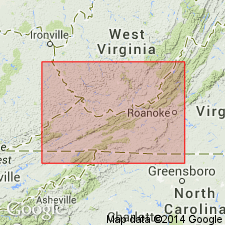
- Usage in publication:
-
- Eggleston Formation
- Modifications:
-
- Revised
- AAPG geologic province:
-
- Appalachian basin
Summary:
The Walker Mountain Sandstone Member is a thin but widespread sheet deposit in the Bays, Moccasin, and Eggleston Formations of the Valley and Ridge province, VA, and TN. The member occurs at the base of the Eggleston in the Rich Patch and Warm Springs Valleys where it unconformably overlies the Witten Formation. Interval was identified by Kay (1956) as a "buff quartz arenite" in his measured sections for Richpatch Cove and McGraw Gap.
Source: GNU records (USGS DDS-6; Reston GNULEX).

- Usage in publication:
-
- Eggleston Formation*
- Modifications:
-
- Overview
- AAPG geologic province:
-
- Appalachian basin
Summary:
Eggleston Formation. According to Ross and others (1982), Ottosee Shale, Moccasin Limestone, and Eggleston Formation of eastern Tennessee correlate with Tyrone Limestone of north-central Tennessee.
Source: Modified from GNU records (USGS DDS-6; Reston GNULEX).

- Usage in publication:
-
- Eggleston Formation*
- Modifications:
-
- Overview
- AAPG geologic province:
-
- Appalachian basin
Summary:
The Eggleston Formation occurs in the subsurface of VA and WV between the St. Clair and Pulaski thrust faults as shown in section F-F'. Overlies the Moccasin Formation or the Witten Limestone and underlies the Martinsburg Formation. The Eggleston is of Middle Ordovician (Rocklandian) age.
Source: GNU records (USGS DDS-6; Reston GNULEX).
For more information, please contact Nancy Stamm, Geologic Names Committee Secretary.
Asterisk (*) indicates published by U.S. Geological Survey authors.
"No current usage" (†) implies that a name has been abandoned or has fallen into disuse. Former usage and, if known, replacement name given in parentheses ( ).
Slash (/) indicates name conflicts with nomenclatural guidelines (CSN, 1933; ACSN, 1961, 1970; NACSN, 1983, 2005, 2021). May be explained within brackets ([ ]).

